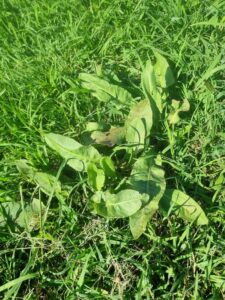
Weed species – a guide to plant choice and soil indicators
By Patrick Regnault
Observing the weed species can tell us a lot about the nutrient availability, soil compaction, recent history of the site, pH, moisture levels, and soil texture. Understanding or reading weeds can guide us in our planting selection. It can help us work successfully with the conditions rather than forcing unsuitable plants upon the land.
Whilst many generations of farmers used this technique in the past, the ornamental garden industry has been far less aware of how this could benefit them. This knowledge was very nearly lost with the advent of modern agricultural techniques and chemical fertilisers. The idea of imposing our will on the land rather than listening to it is contrary to what has been done for millennia across continents.
Weed seeds can stay dormant in the soil for months, years, and even decades. They grow when the conditions are right. By understanding weed biology, we can understand why they are doing so well in a particular area and use that information to guide landscape management.
Some weeds thrive in a wide range of environments, so a single species is not a correct indicator. If many species known to like a specific set of conditions grow together, then they help us better understand the conditions in a particular area. Some plants, like Plantago sp.,are very adaptable but will not grow in alkaline or poorly drained soils. The lack of a weed can also be a very good indicator of conditions.

Oxalis sp. shows that the soil is poor in calcium or that calcium is unavailable. High magnesium or potassium and nitrogen excess can reduce calcium uptake.
Portulaca oleracea (Pig Weed)indicates rich soil, which is high in phosphorus levels whilst onion grass shows the contrary.
Digitaria sp. (Finger Grass) grows exceptionally well in soils low in calcium.
Taraxacum sp. (Dandelion)indicates low calcium but high potassium levels, and sometimes compacted soil.
Sonchus oleraceus (Common Sow Thistle)indicates dry, heavy, acidic and iron deficient soil.
Trifolium repens (White Clover)thrives in nitrogen-deficient soil. The clover is doing its job of fixing and adding nitrogen to the soil. Once encouraged to grow in turf to help with nitrogen, the advent of chemical fertiliser and the desire for the ‘perfect lawn’ made clover a lawn weed.
Amaranthus retroflexus (Red-root Amaranth)is a sign that the iron-manganese ratio is out of balance. Too much of one or the other indicates that the soil is very high in potassium and manganese, and low in phosphorus and calcium.
Elytrigia repens (English Couch)improper iron-manganese ratio
Helenium tenuifolium, campsis radicans, Andropogon virginicus, Urtica dioica, Equisetum arvense, Polygonum convolvulus may all indicate calcium deficiency.
Polygonum convolvulus (Black Bindweed)indicates low phosphorus and excess potassium.
Arctium lappa (Greater Burdock) indicates low calcium, high potassium.
Rumex crispus (Curly Dock) indicates compacted soil, low calcium, extremely high magnesium, phosphorus and potassium.
Chenopodium album (Fat Hen)indicateslow phosphorus high potassium.
Hordeum jubatum (Foxtail Barley) indicates low calcium, high magnesium, compacted and poorly drained.
Centaurea maculosa (Spotted knapweed) indicates low calcium and humus, and very low in phosphorus.
Chrysanthemum leucanthemum (Oxeye Daisy)prefers low phosphorus, high potassium and high magnesium.
Weeds are the lexicon that can help us decipher the land. We can always do our best to rectify the soil to suit our idea of what should be planted there, or we can observe and listen deeply and adapt our idea to the land itself.
If the land has been damaged through construction, mechanical compaction, concrete, paint, or chemical spills, we need to intervene more radically. Weeds can also tell us if this has happened and give us a rough idea of how long ago it occurred.
Understanding weeds does not eliminate the need for soil testing, but rather it can complement it—a first read, if you will. If it has been raining for a while and the ground everywhere is saturated, knowing the weeds helps us identify at first glance where the soil is temporarily wet and where it is more constant.
Patrick Regnault FAIH RH0062
Interactive Landscapes
E: patrickregnault@hotmail.com
